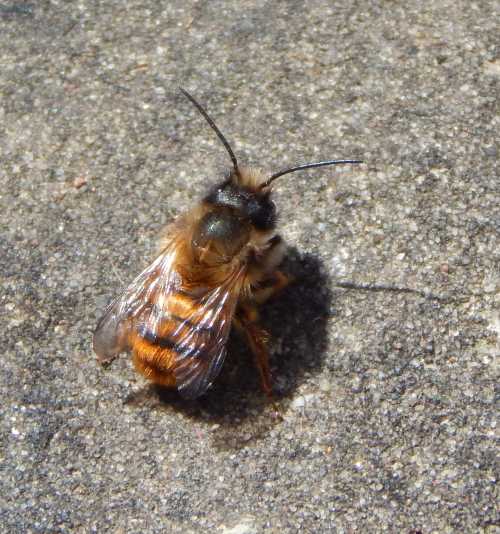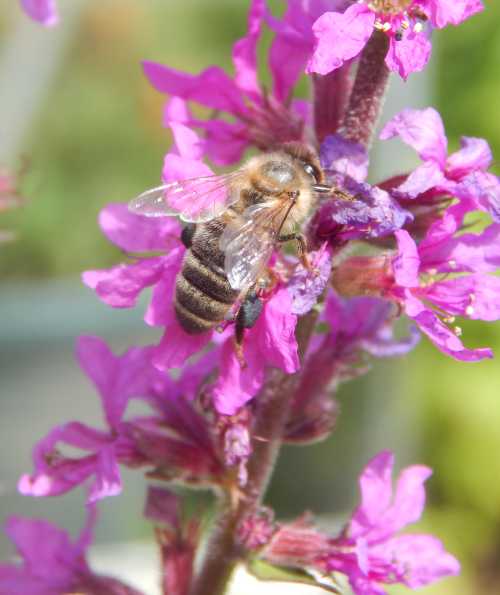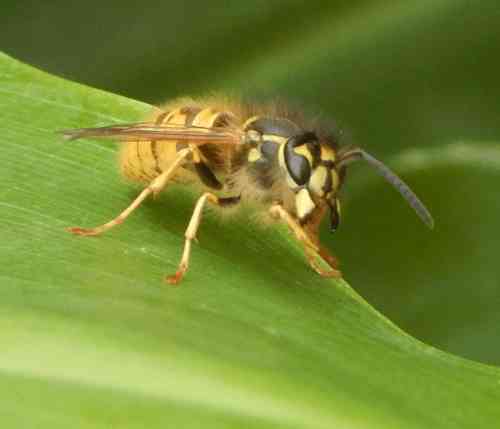Bees Or Wasps In The Chimney
You may find bees or wasps around the fireplace, and perhaps you have become aware that there is probably a nest in your chimney. On the other hand, the chimney may be blocked off and unused, yet you can see bees or wasps entering a hole or crevice.
If you have discovered that you have bees or wasps in your chimney, here are some actions you can take. It really depends:
- on the species.
- your usage of the chimney.
- is the nest inside the chimney itself, or actually on the outside (such as mason bees making use of little holes in the brickwork?).
Bees And Wasps Inside The Chimney
Let's first take a look at the kinds of bees and possible wasp scenarios.

Pictured left is a red mason bee, Osmia bicornis. Again, appearances may vary, but you may see a number of these bees entering individual holes in the brickwork outside (not inside) the chimney. They are not aggressive, and will only be active for a season. They create nest cells in little holes in the mortar, then use damp mud and grit to plug them with. These bees can be left alone. I am not aware of them causing lasting damage to structures.
Below is a short mason bee video showing a mason bee nesting in a hole in mortar.

Left is a honey bee. Honey bees live in large colonies.
Sometimes, a swarm will settle inside a chimney with the intention of nesting there, and making a permanent home. If the chimney is unused, such as in an old outbuilding, and the fireplace is sealed up, you may decide to leave the bees alone, and allow them to make the chimney breast their home. Otherwise, you will require the assistance of a specialist to have them removed.
Once a nest has become established, the process of removing it is a complex one, and you will need to have the bees removed by a specialist company. All of the nest material, the comb must be removed to discourage more bees returning - or to encourage wasps.
Simply using poison on the nest will not work, all of the comb, larvae and detritus must be removed, or various unpleasant pests could take up residence in your chimney. In addition, it is surely better to relocate the bees humanely, rather than kill them.
There will be a charge for this service. Below is a video of honey bee removal from a chimney.
Who provides this service? Since this site receives visitors from all over the world, I cannot include all providers on this page. However:
- In the UK, you could try:
- In the US and Canada, see this page at the American Beekeeping Federation.
- For Australia, try
- Bee Rescue (covering Melbourne to Victoria).
- East Coast Bees (For Queensland)
- Sticky Prick Bee Haven (Perth area)
- Sydney Bee Shop (Sidney)

A wasp nest in a chimney may cause a lot of concern, and may or may not have to be removed, depending on your circumstances. Writing from experience, my sister had a wasp nest in her chimney.
She asked me whether she should light a fire to get rid of them. Since a wasp nest is essentially made of paper made from chewed slithers of wood, I advised her not to do this - she may end up with a chimney fire.
Having a large piece of land and being a keen food and flower grower, she appreciated the service the wasps provided, in terms of eating crop pests.
(Wasps are much maligned, but wasps are actually beneficial). It being summer, she had no need to light the fire. She created a screen at the fireplace, and closed the door to that room, as she didn't need to use that room for a while.
The colony was finished by the autumn (in some parts of the world, colonies can, however, be perennial, and therefore cause problems). Occasionally, bits of old nest fell down the chimney, and she had the chimney cleared out.
If you can seal up the fireplace to stop the wasps entering your room from the chimney, this might be an option for you. Wear protective clothing if you are worried, prepare your materials in advance. Fabric, or even cling film taped securely to the sides, might do the job. Ensure there are no gaps. The debris can be cleared out in the autumn once the colony is no longer active.
On may page about wasp nests, you can read stories from visitors who decided to leave the wasp nest alone.
If you have serious concerns, you will need to call out a specialist company to deal with the nest.